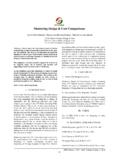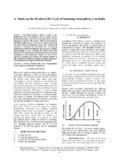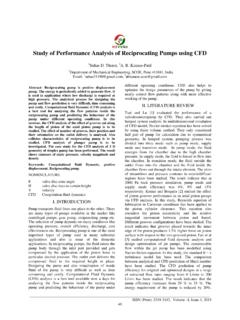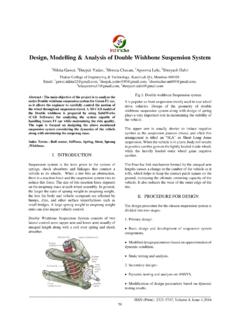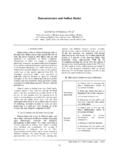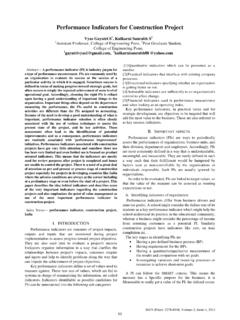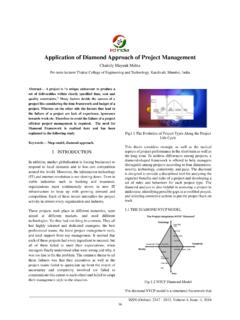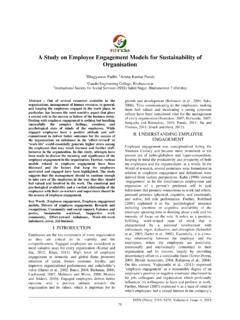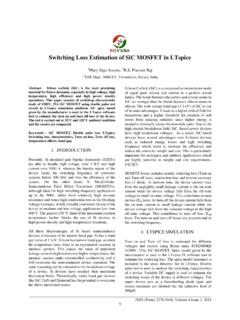Transcription of Consumer Perception Towards Retail Store Image: …
1 International Journal of Research and Development - A Management Review (IJRDMR) _____ _____ ISSN (Print): 2319 5479, Volume-4, Issue 4, 2015 31 Consumer Perception Towards Retail Store image : A Study of the Emerging Retail Formats in Urban Odisha 1K. K. Das, 2 Priyanka Tripathy 1 School of Commerce, Ravenshaw University, Cuttack - 753003, Odisha 2 School of Commerce and Management Studies, Ravenshaw University, Cuttack 753003, Odisha Abstract : The purpose of this study is to identify Store image attributes and evaluate the strength and importance of the influence of each attribute on Consumer purchasing decisions. It examines the impact of various socioeconomic or demographic variables on consumers evaluation of various Store image attributes.
2 601 consumers served as the convenient sample. The correlation between the demographic variables and the various Store image attributes were highly significant. This holds much importance for retailers in today s volatile marketplace and relates to the need for retailers to take into account the impact of Retail Store image and its relationship with Store loyalty. I. INTRODUCTION Driven by the need to maximize profit and compete in volatile marketplaces, retailers are deeply interested in collecting critical information from consumers and attempting to layout stores in ways that will attract their target customers.
3 Despite significant academic and commercial research, many uncertainties remain as to how Consumer behavior affects Store choice (Knee, 2002). Because Store image can be expressed as a function of the salient attributes of a particular Store that consumers evaluate and weight against one another, Store image can also be defined as the combination of a Consumer s perceptions about a Store according to different (salient) attributes. To date, many studies have provided a considerable understanding of Store image , its attributes, and patronage behavior based on the general population, which has become the basis for Retail strategies.
4 This mass-market orientation does not assist local retailers in terms of helping them to focus on a specific market segment and create Store image based strategies. There is still vast scope for research, analysis as the retailing environment changes rapidly, leading to changes in the expectations of shoppers, and a realignment of the choice set of stores (Sinha and Banerjee, 2004). The paper therefore identifies (sector-specific) Store image attributes and evaluates the strength and importance of the influence of each attribute on the purchase decisions of consumers in the emerging Retail formats.
5 To do so, the impacts of various socioeconomic variables on Store image attributes were examined. Socioeconomic, or demographic, variables are the most popular basis for distinguishing customer groups because Consumer wants, preferences, and usage rates are generally associated with such variables. As Doyle and Fenwick (1974) note, different socioeconomic groups perceive stores differently and Store image Perception may be related to age and other demographic factors. The various demographic factors considered included: gender, age, education, occupation, and income. The first section of this paper discusses the main elements of Store image and positioning within the literature.
6 The second section goes on to describe and analyze the research undertaken on the emerging Retail formats in which a sample of 601 respondents were surveyed to elicit the influence of demographic variables on consumers Retail Store image evaluation. II. LITERATURE REVIEW As per Sewell (1974), defining Store image is not easy. Store image is a critical component of Store choice and loyalty (Malhotra, 1983; Nevin and Houston, 1980; Osman, 1993; Stanley and Sewell, 1976). Originally proposed by Martineau (1958), the concept of Store image combines tangible and intangible or functional and psychological attributes.
7 Many researchers, including Ditcher (1985), Keaveney and Hunt (1992), and Zimmer and Golden (1988), subscribe to this view. Store image is considered one of the most important determinants of success (Amirani and Gates, 1993) in the retailing industry. In fact, a unique Store image is one of the retailer s most valuable marketing assets, creating a competitive advantage that is not easily duplicated by other retailers (Rosenbloom, 1983). The image of a Store consists of the way it is perceived by consumers (Zimmer and Golden, 1988). An individual s view is important to the retailer because it can ultimately influence patronage behavior.
8 These views can be used to change consumers reactions to the Store favorably since attributes of merchandising and service can be formed in the viewpoint of consumers. Store image has frequently been defined as an attitude, or set of attitudes, based upon an evaluation of salient International Journal of Research and Development - A Management Review (IJRDMR) _____ _____ ISSN (Print): 2319 5479, Volume-4, Issue 4, 2015 32 Store attributes (Doyle and Fenwick, 1974-1975; Engel and Blackwell, 1982; James et al., 1976) and its measurement almost always involves the identification of a number of attributes which are assumed to collectively make up a Store s image (Hirschman et al.)
9 , 1978; Keaveney and Hunt, 1992). The literature reviewed indicated that there are considerable variations among most researchers in terms of the number of relevant Store image attributes used in their studies dealing with the determinants of Store image . Martineau s (1958) paper has identified layout and architecture; symbols and color; advertising; and sales personnel as the four core attributes of Store image . From a review of nineteen previous studies, Lindquist (1974) has proposed nine Store image attributes. These attributes are: merchandise, which includes factors such as quality, assortment, styling or fashion, guarantees and price; service, consisting of staff service, ease of return, credit and delivery service; clientele, including factors like social class appeal, self image congruency and Store personnel; physical facilities, like layout and architecture; convenience, primarily location related; promotion, which includes sales promotions, product displays, advertising programmes, symbols and colors.
10 Store atmosphere, institutional factors, that include Store projection, reputation and reliability; and post-transaction satisfaction, that come with returns and adjustments. Most of the studies thus far have identified similar groupings of Store image attributes projecting the similar view that the attribute-groupings contribute to a Store s image (Hirschman et al., 1978). According to Ghosh (1994), Store image is composed of eight different elements of the Retail marketing mix: location, merchandise, Store atmosphere, customer service, price, advertising, personal selling, and sales incentive programs.
